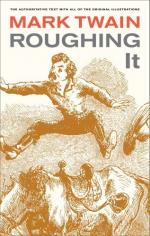The object of our tramp was to visit a great natural curiosity at the base of the foothills—a congealed cascade of lava. Some old forgotten volcanic eruption sent its broad river of fire down the mountain side here, and it poured down in a great torrent from an overhanging bluff some fifty feet high to the ground below. The flaming torrent cooled in the winds from the sea, and remains there to-day, all seamed, and frothed and rippled a petrified Niagara. It is very picturesque, and withal so natural that one might almost imagine it still flowed. A smaller stream trickled over the cliff and built up an isolated pyramid about thirty feet high, which has the semblance of a mass of large gnarled and knotted vines and roots and stems intricately twisted and woven together.
We passed in behind the cascade and the pyramid, and found the bluff pierced by several cavernous tunnels, whose crooked courses we followed a long distance.
Two of these winding tunnels stand as proof of Nature’s mining abilities. Their floors are level, they are seven feet wide, and their roofs are gently arched. Their height is not uniform, however. We passed through one a hundred feet long, which leads through a spur of the hill and opens out well up in the sheer wall of a precipice whose foot rests in the waves of the sea. It is a commodious tunnel, except that there are occasional places in it where one must stoop to pass under. The roof is lava, of course, and is thickly studded with little lava-pointed icicles an inch long, which hardened as they dripped. They project as closely together as the iron teeth of a corn-sheller, and if one will stand up straight and walk any distance there, he can get his hair combed free of charge.
CHAPTER LXXIV.
We got back to the schooner in good time, and then sailed down to Kau, where we disembarked and took final leave of the vessel. Next day we bought horses and bent our way over the summer-clad mountain-terraces, toward the great volcano of Kilauea (Ke-low-way-ah). We made nearly a two days’ journey of it, but that was on account of laziness. Toward sunset on the second day, we reached an elevation of some four thousand feet above sea level, and as we picked our careful way through billowy wastes of lava long generations ago stricken dead and cold in the climax of its tossing fury, we began to come upon signs of the near presence of the volcano—signs in the nature of ragged fissures that discharged jets of sulphurous vapor into the air, hot from the molten ocean down in the bowels of the mountain.
Shortly the crater came into view. I have seen Vesuvius since, but it was a mere toy, a child’s volcano, a soup-kettle, compared to this. Mount Vesuvius is a shapely cone thirty-six hundred feet high; its crater an inverted cone only three hundred feet deep, and not more than a thousand feet in diameter, if as much as that; its fires meagre, modest, and docile.—But here was a vast, perpendicular, walled cellar, nine hundred feet deep in some places, thirteen hundred in others, level-floored, and ten miles in circumference! Here was a yawning pit upon whose floor the armies of Russia could camp, and have room to spare.




